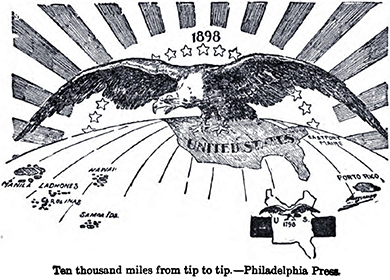| << Chapter < Page | Chapter >> Page > |
As the war closed, Spanish and American diplomats made arrangements for a peace conference in Paris. They met in October 1898, with the Spanish government committed to regaining control of the Philippines, which they felt were unjustly taken in a war that was solely about Cuban independence. While the Teller Amendment ensured freedom for Cuba, President McKinley was reluctant to relinquish the strategically useful prize of the Philippines. He certainly did not want to give the islands back to Spain, nor did he want another European power to step in to seize them. Neither the Spanish nor the Americans considered giving the islands their independence, since, with the pervasive racism and cultural stereotyping of the day, they believed the Filipino people were not capable of governing themselves. William Howard Taft, the first American governor-general to oversee the administration of the new U.S. possession, accurately captured American sentiments with his frequent reference to Filipinos as “our little brown brothers.”
As the peace negotiations unfolded, Spain agreed to recognize Cuba’s independence, as well as recognize American control of Puerto Rico and Guam. McKinley insisted that the United States maintain control over the Philippines as an annexation, in return for a $20 million payment to Spain. Although Spain was reluctant, they were in no position militarily to deny the American demand. The two sides finalized the Treaty of Paris on December 10, 1898. With it came the international recognition that there was a new American empire that included the Philippines, Puerto Rico, and Guam. The American press quickly glorified the nation’s new reach, as expressed in the cartoon below, depicting the glory of the American eagle reaching from the Philippines to the Caribbean ( [link] ).

Domestically, the country was neither unified in their support of the treaty nor in the idea of the United States building an empire at all. Many prominent Americans, including Jane Addams, former President Grover Cleveland, Andrew Carnegie, Mark Twain, and Samuel Gompers, felt strongly that the country should not be pursuing an empire, and, in 1898, they formed the Anti-Imperialist League to oppose this expansionism. The reasons for their opposition were varied: Some felt that empire building went against the principles of democracy and freedom upon which the country was founded, some worried about competition from foreign workers, and some held the xenophobic viewpoint that the assimilation of other races would hurt the country. Regardless of their reasons, the group, taken together, presented a formidable challenge. As foreign treaties require a two-thirds majority in the U.S. Senate to pass, the Anti-Imperialist League’s pressure led them to a clear split, with the possibility of defeat of the treaty seeming imminent. Less than a week before the scheduled vote, however, news of a Filipino uprising against American forces reached the United States. Undecided senators were convinced of the need to maintain an American presence in the region and preempt the intervention of another European power, and the Senate formally ratified the treaty on February 6, 1899.

Notification Switch
Would you like to follow the 'U.s. history' conversation and receive update notifications?